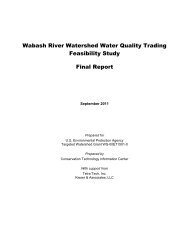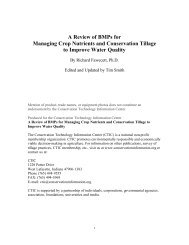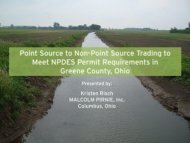Facilitating Conservation Farming Practices and Enhancing ...
Facilitating Conservation Farming Practices and Enhancing ...
Facilitating Conservation Farming Practices and Enhancing ...
You also want an ePaper? Increase the reach of your titles
YUMPU automatically turns print PDFs into web optimized ePapers that Google loves.
No-Till in U.S. Full-Season Soybeans*<br />
As society creates incentives for sustainability, farmers’ ability to<br />
reduce erosion <strong>and</strong> build soil organic matter through conservation<br />
tillage also opens new economic opportunities. U.S. Department<br />
of Agriculture funding for environmental cost-share programs has<br />
increased steadily – from roughly $3 billion in 1990 to $5.6 billion in 2005<br />
– directing billions of dollars annually to conservation-oriented members<br />
of the farm community (U.S. EPA, 2008). Emerging markets for carbon<br />
offsets <strong>and</strong> water quality trading credits show great promise to create<br />
new revenue streams for producers with the interest, skills <strong>and</strong> tools to<br />
adopt best management practices (BMPs) such as no-till farming.<br />
U.S. Soybean Acreage (millions)<br />
80<br />
70<br />
60<br />
50<br />
40<br />
30<br />
20<br />
10<br />
0<br />
2%**<br />
increase<br />
Total acreage<br />
13%<br />
increase<br />
20%<br />
increase<br />
No-till acreage<br />
35%<br />
increase<br />
45%<br />
increase<br />
64%<br />
increase<br />
1995 1996 1997 1998 2000 2002 2004 2008<br />
Year<br />
69%<br />
increase<br />
Biotechnology Facilitates<br />
<strong>Conservation</strong> Tillage<br />
For millennia, farmers have tilled the soil to prepare seedbeds <strong>and</strong> control<br />
weeds, which compete with crops for nutrients, water <strong>and</strong> light, <strong>and</strong><br />
can interfere with harvest. The advent of herbicides in the latter half of<br />
the 20th century allowed growers to combat weeds by chemical means,<br />
though pre-plant tillage <strong>and</strong> the use of post-emergence cultivation are<br />
still quite common.<br />
The use of biotechnology to develop herbicide-tolerant crops was a<br />
breakthrough. Not only did it allow growers to simplify their weed control<br />
practices by using nonselective herbicides after crop emergence, but<br />
also those herbicides were so broad in their weed control spectrum<br />
<strong>and</strong> so reliable that pre-plant tillage was no longer necessary. The<br />
herbicide-tolerant crops made it far easier <strong>and</strong> less risky to adopt conservation<br />
tillage <strong>and</strong> no-till.<br />
In 1995, the year before glyphosate-tolerant soybeans were introduced<br />
to the market, approximately 27 percent of the nation’s fullseason<br />
soybeans were no-tilled, according to the <strong>Conservation</strong><br />
Technology Information Center (CTIC, 1995). The latest surveys by<br />
CTIC indicate that 39 percent of U.S. full-season soybean acres are<br />
no-tilled today, a phenomenon that closely tracked the adoption of<br />
herbicide-tolerant soybeans.<br />
Source: <strong>Conservation</strong> Technology Information Center (adapted from Johnson et al., 2007)<br />
*Partially updated data: 2008 data from 2/3 of the counties in Iowa; 2007 data for Indiana <strong>and</strong> some counties in Virginia<br />
<strong>and</strong> Minnesota; 2006 data for Illinois, some counties in Missouri <strong>and</strong> Nebraska; 2004 data for the rest.<br />
**Relative to 1995<br />
In some states, no-till acres dominate the soybean l<strong>and</strong>scape. For<br />
example, 69 percent of Indiana’s soybeans were no-tilled in 2007 as<br />
well as 72 percent of Maryl<strong>and</strong>’s <strong>and</strong> 63 percent of Ohio’s. Fifty percent<br />
of the soybeans in Illinois, 43 percent in South Dakota <strong>and</strong> 40 percent<br />
in Iowa were also no-tilled (CTIC, 2008).<br />
Fighting Erosion<br />
The growth of conservation tillage <strong>and</strong> no-till acreage has a significant<br />
impact on soil, water <strong>and</strong> air quality, which trace back to dramatic<br />
reductions in soil erosion. No-till farming can reduce soil erosion by 90<br />
to 95 percent or more compared to conventional tillage practices, <strong>and</strong><br />
continuous no-till can make the soil more resistant to erosion over time.<br />
In fact, Baker <strong>and</strong> Laflen (1983) documented a 97-percent reduction in<br />
sediment loss in a no-till system. Fawcett et al. (1994) summarized natural<br />
rainfall studies covering more than 32 site-years of data <strong>and</strong> found<br />
that, on average, no-till resulted in 70 percent less herbicide runoff, 93<br />
percent less erosion <strong>and</strong> 69 percent less water runoff than moldboard<br />
plowing, in which the soil is completely inverted.<br />
9








